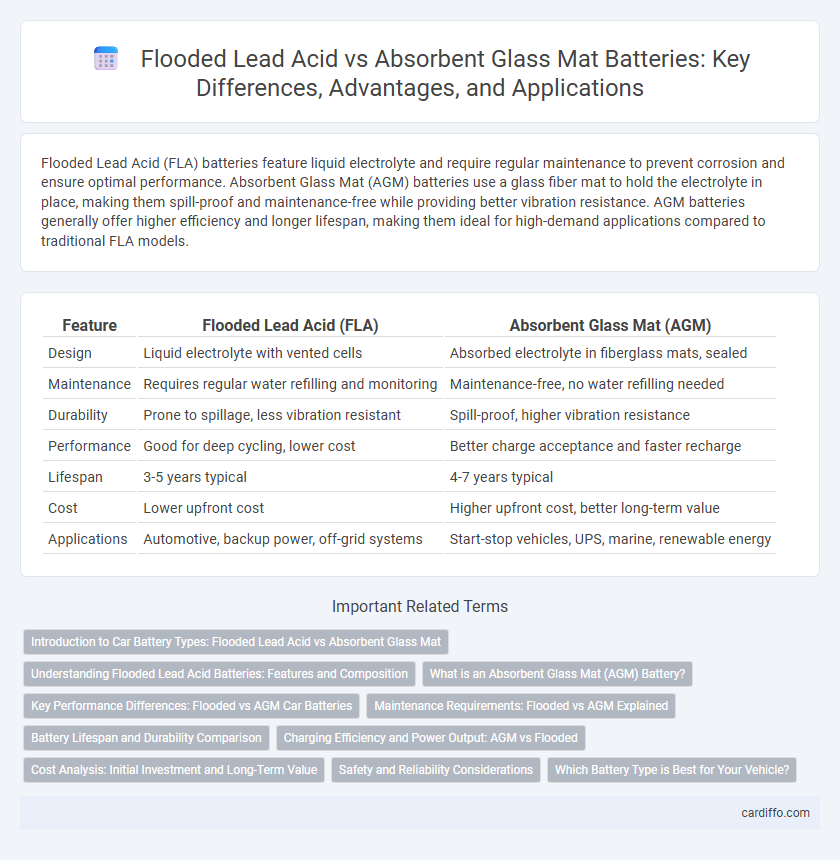Flooded Lead Acid (FLA) batteries feature liquid electrolyte and require regular maintenance to prevent corrosion and ensure optimal performance. Absorbent Glass Mat (AGM) batteries use a glass fiber mat to hold the electrolyte in place, making them spill-proof and maintenance-free while providing better vibration resistance. AGM batteries generally offer higher efficiency and longer lifespan, making them ideal for high-demand applications compared to traditional FLA models.
Table of Comparison
| Feature | Flooded Lead Acid (FLA) | Absorbent Glass Mat (AGM) |
|---|---|---|
| Design | Liquid electrolyte with vented cells | Absorbed electrolyte in fiberglass mats, sealed |
| Maintenance | Requires regular water refilling and monitoring | Maintenance-free, no water refilling needed |
| Durability | Prone to spillage, less vibration resistant | Spill-proof, higher vibration resistance |
| Performance | Good for deep cycling, lower cost | Better charge acceptance and faster recharge |
| Lifespan | 3-5 years typical | 4-7 years typical |
| Cost | Lower upfront cost | Higher upfront cost, better long-term value |
| Applications | Automotive, backup power, off-grid systems | Start-stop vehicles, UPS, marine, renewable energy |
Introduction to Car Battery Types: Flooded Lead Acid vs Absorbent Glass Mat
Flooded Lead Acid (FLA) batteries use liquid electrolyte and require regular maintenance, making them ideal for traditional automotive applications. Absorbent Glass Mat (AGM) batteries feature a fiberglass mat separator that absorbs the electrolyte, resulting in a spill-proof design with superior vibration resistance. AGM batteries provide faster charging and longer lifespan compared to Flooded Lead Acid, making them suitable for modern vehicles with higher electrical demands.
Understanding Flooded Lead Acid Batteries: Features and Composition
Flooded lead acid batteries consist of lead plates submerged in an electrolyte solution of sulfuric acid and water, enabling efficient electrochemical reactions for energy storage. These batteries feature a liquid electrolyte that requires regular maintenance, such as checking water levels and ensuring proper ventilation due to gas emission during charging. Their robust design offers high surge currents and cost-effectiveness, making them ideal for applications like automotive starters and renewable energy systems.
What is an Absorbent Glass Mat (AGM) Battery?
An Absorbent Glass Mat (AGM) battery is a type of sealed lead-acid battery that uses fiberglass mats to absorb the electrolyte, preventing spills and enhancing vibration resistance. AGM batteries offer faster charging, lower self-discharge rates, and better performance in deep-cycle applications compared to traditional flooded lead-acid batteries. Their maintenance-free design and improved safety make them ideal for automotive, marine, and renewable energy storage systems.
Key Performance Differences: Flooded vs AGM Car Batteries
Flooded Lead Acid batteries offer a lower initial cost and easier maintenance but suffer from lower charge efficiency and shorter cycle life compared to Absorbent Glass Mat (AGM) batteries, which provide superior vibration resistance, faster recharging, and deeper discharge capabilities. AGM batteries maintain a spill-proof design with enhanced durability, making them ideal for high-performance automotive applications requiring consistent power delivery. Key performance metrics highlight AGM's higher energy density and lower self-discharge rate, crucial for long-term reliability in modern vehicles.
Maintenance Requirements: Flooded vs AGM Explained
Flooded lead acid batteries require regular maintenance, including water refilling and checking for corrosion, to ensure optimal performance. Absorbent Glass Mat (AGM) batteries are sealed and maintenance-free, offering enhanced durability and resistance to vibration. AGM batteries are ideal for users seeking low-maintenance solutions without compromising power and reliability.
Battery Lifespan and Durability Comparison
Flooded Lead Acid (FLA) batteries generally offer a lifespan of 3 to 5 years, with durability dependent on regular maintenance such as electrolyte refilling and equalization charging. Absorbent Glass Mat (AGM) batteries typically provide a longer lifespan of 4 to 7 years and superior durability due to their sealed design that resists vibration and reduces the risk of acid stratification. The maintenance-free nature and enhanced resistance to deep discharge cycles make AGM batteries a more reliable choice for applications demanding extended durability and lifespan.
Charging Efficiency and Power Output: AGM vs Flooded
Absorbent Glass Mat (AGM) batteries demonstrate higher charging efficiency than Flooded Lead Acid batteries, as their sealed design reduces electrolyte stratification and water loss, promoting faster and more consistent charging cycles. AGM batteries deliver superior power output due to lower internal resistance, enabling better performance in high-demand applications like starting engines or powering renewable energy systems. Flooded Lead Acid batteries, while more cost-effective, typically exhibit slower recharge rates and lower peak power output, making them less efficient for rapid energy delivery requirements.
Cost Analysis: Initial Investment and Long-Term Value
Flooded Lead Acid (FLA) batteries typically have a lower initial investment cost compared to Absorbent Glass Mat (AGM) batteries, making them attractive for budget-conscious applications. However, AGM batteries offer longer service life and reduced maintenance requirements, translating to lower total cost of ownership over time. The long-term value of AGM batteries often justifies their higher upfront expense through improved cycle life and enhanced performance in demanding environments.
Safety and Reliability Considerations
Flooded Lead Acid (FLA) batteries are known for their robustness and ease of maintenance but require proper ventilation to prevent hydrogen gas buildup, posing safety risks in enclosed spaces. Absorbent Glass Mat (AGM) batteries offer enhanced safety with sealed construction that reduces acid leakage and gas emission, making them more reliable in harsh environments. AGM batteries also provide better vibration resistance and longer cycle life, increasing overall dependability in critical applications.
Which Battery Type is Best for Your Vehicle?
Flooded Lead Acid batteries offer cost-effective power with easy maintenance but require regular water refills and ventilation due to gas emissions. Absorbent Glass Mat (AGM) batteries provide superior performance with higher tolerance to vibration, longer lifespan, and maintenance-free operation, making them ideal for modern vehicles with advanced electrical systems. Choosing between Flooded Lead Acid and AGM depends on your vehicle's power demands, maintenance preferences, and budget constraints.
Flooded Lead Acid vs Absorbent Glass Mat Infographic

 cardiffo.com
cardiffo.com